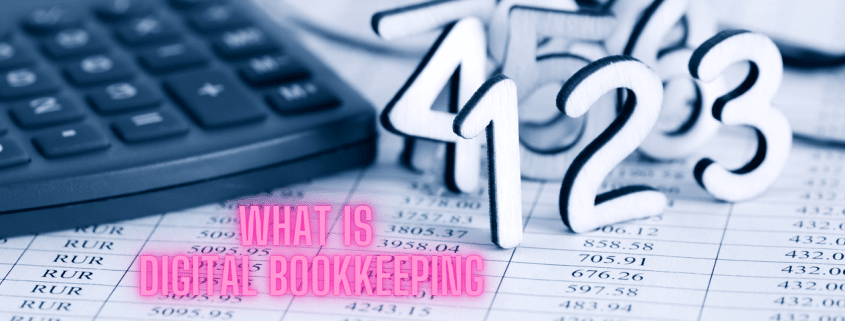What is Digital Bookkeeping?
Electronic bookkeeping entails using technological and software tools to manage a firm’s financial accounts. In this current generation, where almost every function of our daily lives is engaged with technology, digital bookkeeping is the order of the day. Automation of small businesses and startups is proliferating due to the need for digital bookkeeping to increase companies’ profitability and efficiency of work.
Essentially, digital bookkeeping is the ability to maintain and record business financial transactions using different internet-based platforms and application software. Accounting is made up of clumsy, quick, prone-to-errors, and handwritten transactions on physical registers or books. Digital bookkeeping, of all financial transactions, eliminates the taking of records on paper and then entering potentially inaccurate data; thus digital bookkeeping results in better efficiency.
Digital bookkeeping entails the following processes:
Recording transactions: This captures data from financial contracts such as invoices, receipts, and bank statements, and enters it into a computerized accounting system. It can be done manually, although it is more effective to do it through cloud-based platforms or applications that pull data directly from the bank or other financial institutions.
Categorizing and classifying: Having entered the data, it is required to sort it and classify it further according to the type of the transaction, dividing expenses, revenue, and other financial transactions into appropriate accounts. The digital bookkeeping software makes this more accessible in that the transactions are classified according to set rules and matched to similar previous transactions.
Reconciling accounts: This compares the physical books with your bank statement and other financial accounts to verify if it’s correct and how to identify any inconsistency. Most digital bookkeeping has features that enable the comparison of the two sets of records and sends alerts when there is a disagreement that requires handling.

Benefits of Implementing Digital Bookkeeping
Efficiency and Speed: Digital bookkeeping enhances productivity in the accounting sector since it is faster.
Cost Savings: Cloud bookkeeping eliminates most of the general expenses of traditional bookkeeping, like printing and storing papers, stationery, and labor. Most of the online accounting software today has a subscription charge, which could be more affordable than hiring an actual bookkeeper.
Improved Accuracy: Incorporating automated processes in digital bookkeeping also dramatically lessens the footprint of human errors, which tend to be part of manual data entry. This fosters greater accountability since the details of financial statements are more credible when a decision is made or at the time of financial reporting.
Accessibility and Collaboration: Electronic bookkeeping enhances information between teams in an organization. Work and information sharing are easier since everybody can update the project simultaneously resulting in increased efficiency.
Security and Backup: The main advantage of digital bookkeeping software is that it provides encryption and multi-factor authentication to safeguard financial records. Furthermore, these platforms offer data backup services in case the firm’s financial documents or other critical sensitive information are for some reason lost.
Digital bookkeeping in businesses
Choose the right software: Currently, there are many applications and programs for bookkeeping, starting from small applications and ending with complex cloud platforms. You should select which will suit your business type, wallet, and experience level.
Set up a chart of accounts: A chart of accounts is a list of all accounts used to record the business’s financial information with the group of accounts broken down into assets, liabilities, equity, incomes, and expenses. This creates the foundation of your financial reporting and should be specific to your company’s requirements.
Train your team: Your employees need to be trained on the transition to digital bookkeeping; appropriate software should be used. This can be done through actual courses taken face-to-face or through online sessions like webinars or tutorials, depending on the software.
Maintain proper records: To ensure appropriate records of financial information, it is recommended to input the data commonly in digital bookkeeping software. Keep all invoices, receipts, and bank statements in order, as most are used to stem or cross-check.

Types of Digital Bookkeeping Software
Desktop Accounting Software: These software types are installed on a user’s PC or laptop. They are suitable for business organizations with more extensive accounting requirements.
Cloud-Based Accounting Software: These platforms are online-based, and information saved on the client’s device is preserved on servers elsewhere. Prominent cloud-based applications such as FreshBooks, Wave, or Zoho Books can easily automate tasks like invoicing and bookkeeping. This makes them suitable for organizations that would want employees to access or analyze financial information from the comfort of their offices, or share information with their counterparts in other departments or facilities.
Mobile Apps: Expensify, Receipt Bank, Shoeboxed, and more can easily be used by employees who travel frequently or employees who work from home, as most of these apps allow easy recording of expenses and management of receipts from the ease of your mobile phone.
Choosing to record accounts digitally can be difficult, but in the long run, small businesses can be offered many more benefits than detriments. By selecting the best software, developing an appropriate chart of accounts, and even offering the proper training to your staff, you can use digital bookkeeping in your business to improve the financial management practices within your company.



